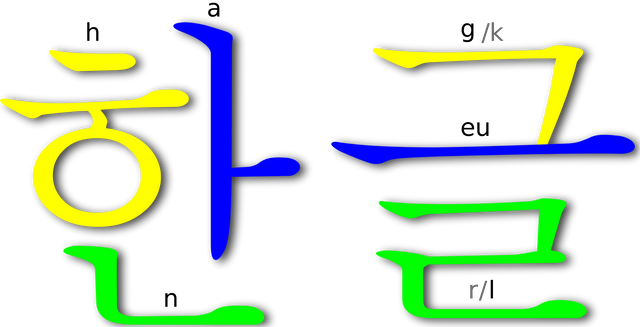Learn How To Read And Write Using Hangul (Korean Alphabet): Lesson 2
Hello, and welcome to lesson 2 of learning how to read and write using the Korean alphabet known as Hangul. In Lesson 1 we learned the story behind Hangul and how it was effectively commissioned by King Sejong.
In today’s lesson, we will learn how exactly Hangul works. Hangul is a phonetic alphabet which is written in syllable blocks but there are certain rules that need to be followed:
- The first letter in a syllable block must be a consonant.
- Said consonant must then be followed by a vowel.
- An OPTIONAL third character can be added to the syllable block, but it must be a consonant again.
Let’s look at the word ‘Hangul’ for instance. It is a two syllable word (‘Han’ and ‘gul’) and you can see each syllable block follows the pattern of consonant-vowel-consonant. This is how you will write it using Hangul:
H – ㅎ (‘H’ as in **h**appy, **h**ave, **h**ere)
A – ㅏ (‘A’ as in g**u**n, p**u**n, s**u**n)
N – ㄴ (‘N’ as in **n**o, **n**ow, **n**ight)
Written as 한.
G – ㄱ (‘G’ as in **g**o, **g**uy, **g**ift)
U – ㅡ (‘U’, also spelt as ‘EU’, as in l**i**ft, b**i**d, n**e**rd)
L – ㄹ (‘L’ as in **l**ove, **l**ife, **l**eft)
Written as 글.
If we put it together it will be written as 한글.
Congrats, you have learned to read your first word in 한글! But let’s try another one and go with the name ‘John.’ It has one syllable, it starts with a consonant(good), is followed by a vowel(good) and finishes up with another consonant(good). The ‘h’ is silent so we are not going to bother with it. This is what it will look like:
J – ㅈ (‘J’ as **j**ump, **j**oy, **J**ames)
O – ㅗ (‘O’ as in b**o**rn, s**oa**r, f**o**r)
N – ㄴ (Covered this one in 한글)
So it will be written as 존.
Now, I am sure you are thinking this is all well and good, but what if a word, or syllable block, needs to have a vowel as its first sound? No problem, I say to you. All you do then is make use of what is effectively a consonant placeholder that looks like this: ㅇ. Just a tiny little circle.
But practice makes perfect, so let’s give it a go. Let’s use the word ‘apple.’ It has two syllables as in ‘ap’ and ‘ple,’ but if you use 한글, it will have two syllables as in ‘a’ and ‘ple.’ So here goes:
Placeholder – ㅇ (It is silent so it has no sound)
A – ㅐ (‘A’ as in b**a**ng, s**a**ng, m**a**n)
Written as 애.
P – ㅍ (‘P’ as in **p**ear, **p**ie, **p**izza)
L – ㄹ (It’s in 한글;)
But now we have a problem because we have a consonant following a consonant and this is no good. So we need to split them up with a vowel. We will use ‘ㅡ.’ You know that one. It is in 한글.
So it will be written as 플.
Put it together and you have 애플.
Finally, what do you do if you have two vowels following each other? Once again, my friend, no problem. All you do is start a new syllable block making use of the silent consonant placeholder thingamajig. I’m sure it has an official name, but we can figure that out later.
So the word ‘pie’ would be a good example. Remember that 한글 is a phonetic alphabet, so you should use the 한글 characters according to sound, not necessarily according to their equivalent in whatever alphabet you may be using. So if we sound it out, it sounds as if we are saying ‘pai.’ So this is how you will write it:
P – ㅍ (You got this in 애플)
A – ㅏ (Remember 한글?)
Placeholder – ㅇ
I – ㅣ (‘I’ as in **i**n, m**e**, h**y**mn)
Hence we will write ‘pie’ as 파이.
And that, my friend, is Lesson 2. I hope you enjoyed it and I would be happy to answer any question in the comments. Have yourself a great day and talk soon.
